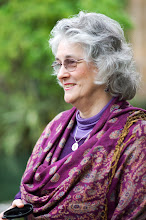 Yesterday I set out to attend the re-dedication of the peace pole on the campus of Dominican University. Our local Dominican Sisters, colleagues in Marin Interfaith Council, do this each year. In the past, when my friend Sister Marion headed the order's Social Justice Committee, I have been an active participant. This year, when the event was announced at an MIC clergy luncheon, I spoke with Sister Marion, who's now retired, about participating; she said that whoever was in charge had already formulated all their plans and that I should just show up. Well, I did, but, I'm embarrassed to say, I had written the event in my calendar as taking place at noon when in fact it began at 11 am. So I arrived just as they were concluding.
Yesterday I set out to attend the re-dedication of the peace pole on the campus of Dominican University. Our local Dominican Sisters, colleagues in Marin Interfaith Council, do this each year. In the past, when my friend Sister Marion headed the order's Social Justice Committee, I have been an active participant. This year, when the event was announced at an MIC clergy luncheon, I spoke with Sister Marion, who's now retired, about participating; she said that whoever was in charge had already formulated all their plans and that I should just show up. Well, I did, but, I'm embarrassed to say, I had written the event in my calendar as taking place at noon when in fact it began at 11 am. So I arrived just as they were concluding.In 1981, the UN General Assembly passed a resolution declaring an International Day of Peace, and in 2001, it adopted the resolution declaring September 21 of each year International Day of Peace. This year's theme is "Youth for Peace and Development."
Since its inception, Peace Day has marked our personal and planetary progress towards peace. It has grown to include millions of people in all parts of the world, and each year events are organized to commemorate and celebrate this day. Events range in scale from private gatherings to public concerts and forums [sic] where hundreds of thousands of people participate. Anyone, anywhere, can celebrate Peace Day.Last night I missed most of the nightly news I usually watch, but I suspect there were hostile engagements taking place yesterday in spite of the best intentions of those of us who seek to promote peaceful resolutions to conflict.
International Day of Peace is also a Day of Ceasefire -- a day in which armed conflict is meant to be stilled; a day on which we appeal to combatants to observe a ceasefire; a day on which we reaffirm a commitment to non-violence and the peaceful resolution of disputes.
What was extra special about this year's ceremony was that the words that roughly translate to "May peace prevail on Earth" in the local Coast Miwok** language were to be added. "Hiya aa puli suta weyyatto."* The pole was blessed by the Coast Miwok and all others who were there. Until yesterday, the pole bore those words in English, French, Spanish, and Arabic.***
The assembled people exchanged peace greetings in Arabic: As-salaam aleikhum, Wa-Leikhum As-salaam; Hebrew: Shalom aleichem, Alechem shalom; Serbo-Croatian: Mir nek bude tebi, Nek tebi bud emir; Chinese: Hun pink ban sway nee, Ban sway nee huh ping; Masai/African: Wenna kanta laf-fi, Laf-fi la Bumbu ("God gives peace. Peace is something special."); German: Frie de sei mit Dir, Und mit Dir sei Frie-de; and Coast Miwok: Puli sutammi mikkoni.
In addition to offering prayers for peace from different religious traditions, people sang several songs from song sheets provided by the Sisters. There were the usual, such as "Let There Be Peace on Earth,"to the Pagan-ish "Circle Round," by Linda Hirschhorn, to the utterly wonderful John Lennon song, "Imagine." This last included an additional verse written by fifth grade students at Cornell School in Albany, California.
There is good news in that even though I was late arriving I did meet someone I had hoped to meet there. She is Joanne Campbell, a Tribal Council Elder with the Federated Indians of Graton Rancheria. Graton Rancheria is comprised of Coast Miwok and Southern Pomo peoples. I invited her to participate in the third annual People of the Earth conference at the Interfaith Center at the Presidio of San Francisco in November.**** As soon as I have more concrete information to give her, I'll follow up on this invitation.Imagine that our leaders
Would listen to our voices
And instead of riches
They cared about our choices
Imagine all the people
Caring for the earth...
The Dominican Sisters of San Rafael's report on this event, with lots of photos, is here.
During the afternoon I attended Marin Interfaith Council's Annual Meeting, where we did a lot of thanking of various individuals for their work,reviewed the budget, and officially installed Fu Schroeder of Green Gulch Zen Center as MIC's representative to the Marin Community Foundation.
* The "s" in the word "suta" should be underlined, not an option in this blog program.
** Coast Miwok people greeted Francis Drake when he first landed on the shores of Marin County in 1579 and other Europeans who entered what it now San Francisco Bay. See "Big Time."
*** While we American Pagans all speak English, and most perform their rites in that language, given the spirit of the annual re-dedication, I would imagine the sisters might consider adding these words of peace in Gaelic, assuming some Druid group involved in interfaith activities were to propose it.
**** Unfortunately, there is no announcement on the ICP website nor any flier for this yet. Watch my FaceBook page for updates.
